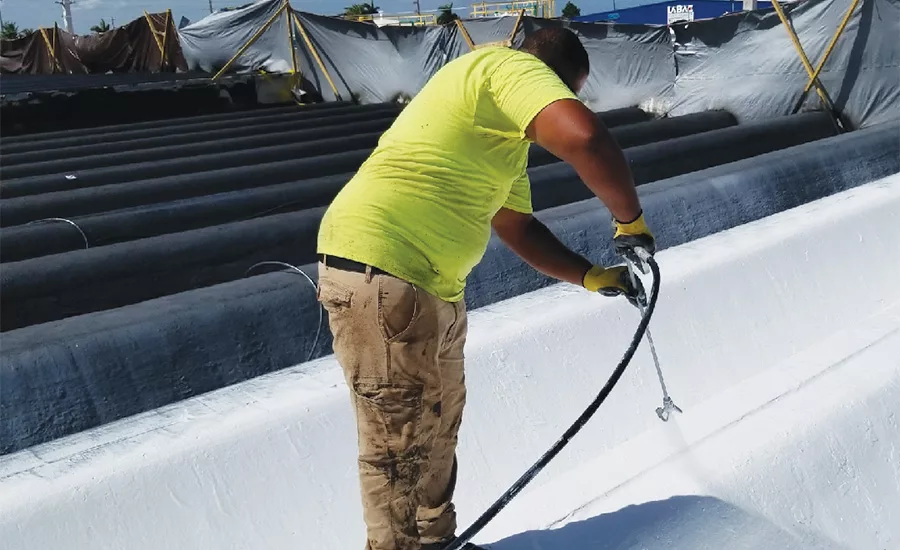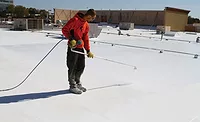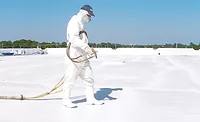Roof Coatings Special Section
Roof Coatings Q&A with the Experts
Dan Quinonez and Chadwick Collins of RCMA

Anecdotal evidence and RC survey data show that the use of coatings is on the rise for roofing contractors around the country. With a little investment in training and equipment that they may already have, contractors can quickly incorporate roof coatings into their service offerings.

Anecdotal evidence and RC survey data show that the use of coatings is on the rise for roofing contractors around the country. With a little investment in training and equipment that they may already have, contractors can quickly incorporate roof coatings into their service offerings.
Dan Quinonez, executive director of the Roof Coatings Manufacturers Association (RCMA), and Chadwick Collins, director of technical services, recently answered the following from RC.
RC: Describe the current state of the roof coatings market in the U.S.?
RCMA: The current state of the market is good, and while the size of the market has grown, we have seen a slight shift in the mix within the market. Silicone and polyurethanes have really gained traction from their position a few decades ago. Thanks to the overall growth of the market, other coatings such as acrylics, aluminized, and emulsions, continue to be major players.
The approach to coatings has changed drastically. Whereas a coating may have been viewed as a short-term solution in the past, coatings now enjoy a position as an enhancement to a new or current roofing system due to the performance properties a coating brings to the roof.
RC: Is now the right time for roofing contractors to get involved?
RCMA: A roof coating should be discussed and considered as part of any life cycle plan for a roofing system. Many coatings can be used with spray equipment that many contractors already have and that adds further return on that investment. Also, the knowledge of roof coatings is more widespread than ever. The ability for architects, building owners, specifiers and consultants to identify and evaluate products for selection has never been higher, and the ability to present roof coating as a viable option is the best it has ever been. The roof coating industry is diverse enough that a product is available for nearly every roofing situation.
RC: Is the recent spike in applications sustainable?
RCMA: We are very proud of the growth of not only the market, but the acceptance of roof coatings as a viable option by those that select and those that install our products. The flexibility and options that roof coatings provide contractors and ultimately, building owners, has a value that the market has responded well to and we see continuing in the future.
RC: What are the challenges contractors face to get involved with coatings?
RCMA: From in an investment perspective, the barrier to entry is relatively low. Most equipment needed can be rented, or is already in the contractor’s possession for the application of other products. The primary barrier is the people side of the equation. The site-manufactured nature of liquid coatings takes a different mindset to get the key aspects, such as surface prep and coverage rate. Many roofers are exposed to these concepts when installing adhesives used in other roofing configurations, so the amount of training to get to what is necessary for successful coating application is not high, but vital for a proper installation nonetheless. With a little investment in training and utilizing equipment they may already have, a contractor could quickly add roof coatings to their portfolio of services.
RC: Do the potential roof costs savings alone mean coatings are here to stay?
RCMA: We don’t deny there’s a cost benefit to using coatings in certain roofing situations, but it’s only one of the reasons that coatings will continue to hold a place in the market. Others include ease of installation, reflectivity, minimal equipment, avoidance of tear-off, and extended life cycle. While all of these have a cost component, they also possess other positive attributes that make roof coatings a viable option.
RC: How have coatings applications evolved to be more environmentally friendly?
RCMA: First, let’s talk about the roof. A coating can help extend the life of a current roofing system. An extended life means a delay of disposal. What develops in that extended timeline? Perhaps more recycling options become available in that market, new technology is introduced that extends the roof even further — we never know what will happen. But an extended roof life allows for that possibility rather than the existing material being disposed to a landfill.
Specifically, more products today have lower VOCs and the industry continues to push those limits lower. Many building owners also select coatings for their reflectivity, which can assist in energy consumption, especially at peak loading.
Many roof coatings today were born from this push for “green friendly” and our industry will continue to innovate in this space.
RC: What about codes for installation? Are they getting rougher and tougher for contractors?
RCMA: Codes and regulations are a part of being in the construction industry. Each segment has its own pieces and parts of the code and regulations that can present challenges when trying to select and install a product. The RCMA continues to monitor and participate in the code and regulation development process to provide input and guidance in an effort to avoid burdensome requirements while supporting the goals of keeping people safe and installing the products properly. We believe some of the best work we can do, and do more of, is being available to assist in educating those that work with the code to ensure that interpretation of the code is consistent, both in meaning and in action.
RC: Are coatings safer to use today?
RCMA: Safety training and equipment has evolved, not just for roof coatings, but also for roofing in general a great deal. With the internet, everyone has access to the proper safety data sheets for any product. The harmonization of these documents across many sectors has helped simplify the communication for the installer to review and understand what equipment is needed and when. Finally, working a roof, whether installing roof coatings or any other product, continues to carry the hazards of falls and heat-related risks. We always advocate that anyone installing products should be trained and follow the proper practices needed to be safe on a roof.
RC: What are you excited about for the future of this segment of the roofing industry and how big can it get?
RCMA: The future of this segment is always exciting. We continue to expect growth. Our products inherently offer features that other products do not and we see no shortage of the need for these features down the road. Now, just looking to the past few decades, we know that the mix of products in our segment will likely change, new technologies and families of products will be introduced, but roof coatings as a segment will not go away.

Looking for a reprint of this article?
From high-res PDFs to custom plaques, order your copy today!







